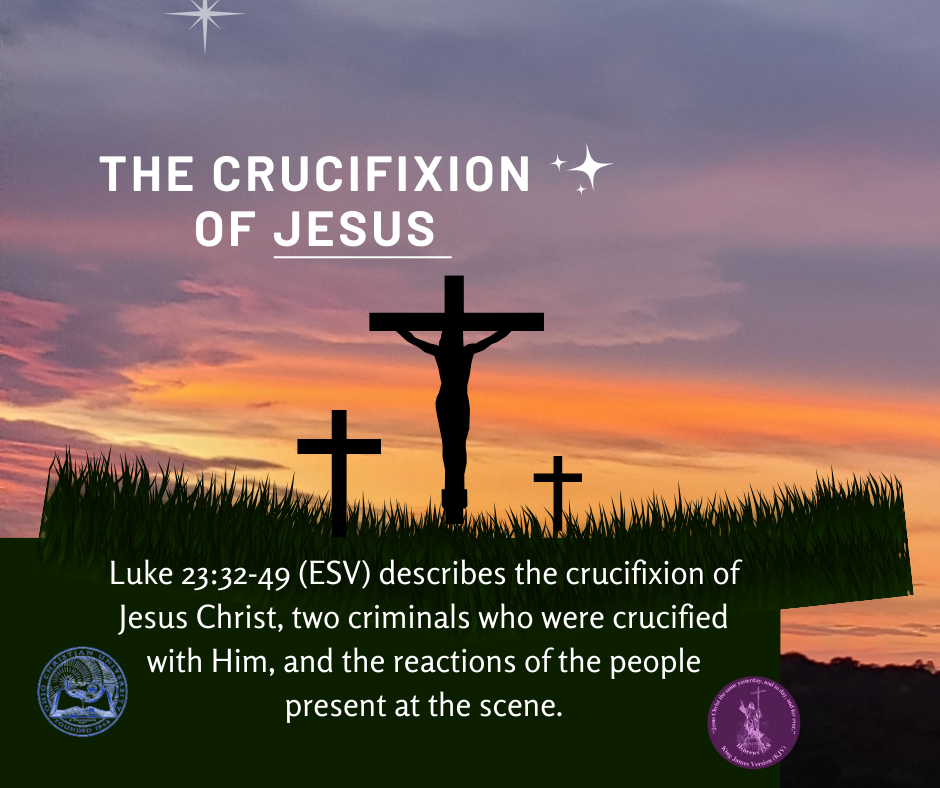Written By Lesallan – September 11, 2023

Luke 23:32-49 (ESV): Detailed Analysis
Version: ESV
INITIAL OBSERVATIONS & QUESTIONS
• This passage (Luke 23:32-49, ESV) describes the crucifixion of Jesus and two criminals and the reactions of the people who witnessed it.
o What does it mean to be a criminal in this context?
• This passage mentions two criminals crucified with Jesus, one on his right and one on his left (Luke 23:33, ESV).
o How did Jesus relate to these criminals?
• This passage records that Jesus said, “Father, forgive them, for they know not what they do” (Luke 23:34, ESV).
o What does it mean to forgive someone who has wronged us?
• The passage mentions that the soldiers mocked Jesus by saying, “He saved others; let him save himself” (Luke 23:35, ESV).
o How did Jesus respond to this accusation?
• This passage reports that the soldiers mocked Jesus by offering him sour wine and saying, “If you are the King of the Jews, save yourself” (Luke 23:36-37, ESV).
o How did Jesus respond to these insults?
• This passage states an inscription over Jesus read, “This is the King of the Jews” (Luke 23:38, ESV).
o What does it mean to be called the King of the Jews?
• The two crucified criminals had different attitudes toward Jesus and their fate (Luke 23:39-43, ESV).
o What does it mean to fear God and to receive the due reward for our deeds?
• The darkness and the tearing of the temple curtain were signs of God’s judgment and wrath against sin (Luke 23:44-46, ESV).
o How can we express our faith in Jesus as our Lord and Savior?
• The centurion who witnessed Jesus’ death praised God for His innocence, and the crowds who saw it mourned for Him (Luke 23:47-49, ESV).
o How does Jesus’ death fulfill the prophecies of the Old Testament about the Messiah?
• The passage describes the agony of Jesus on the cross and the compassion of the women who followed Him.
STRUCTURE
Luke 23:32-49 (ESV) comprises a section that chronicles the crucifixion of Jesus and the reactions of those who bore witness to it. This section is closely linked to the preceding and subsequent sections that detail the events leading up to and following Jesus’ death, resurrection, and Ascension. The section illustrates how Jesus fulfilled God’s plan for Israel and the world by offering Himself as a sacrifice for sin and rising again as the King of the Jews. It also highlights how Jesus demonstrated His compassion and authority by forgiving His enemies, consoling His mother’s sorrow, and revealing His identity to His disciples. Furthermore, the section contrasts earlier sections that depict Jesus as a humble servant who came to serve rather than be served and taught with authority but not with violence. The section reveals how Jesus fulfilled His mission by dying as a servant and rising again as a king.
Luke 23:32-49 (ESV) comprises three principal sections interconnected by semantic and rhetorical structures. The first section (Luke 23:32-34, ESV) introduces the central theme of the passage, which centers on Jesus’ identification with His people and His role as the good shepherd. The second segment (Luke 23:35-37, ESV) depicts how Jesus was rejected by His own people and accused of being a savior who could not save Himself. The third section (Luke 23:38-43, ESV) reveals how Jesus fulfilled His mission by expiring as a sacrifice for sin and rising again as the King of the Jews. The text also employs various rhetorical devices, including contrast, comparison, particularization, generalization, causation, substantiation, climax, cruciality, interrogation, instrumentation, preparation/realization, and summarization (Bauer & Traina, 2014) to underscore the meaning and significance of Jesus’ words and actions.
I. Jesus is crucified (Luke 23:32-38, ESV).
A. Jesus is crucified with two criminals (Luke 23:32-33, ESV).
B. Jesus prays for his executioners (Luke 23:34, ESV).
C. The soldiers mock Jesus (Luke 23:35-38, ESV).
II. Jesus dies on the cross (Luke 23:39-46, ESV).
A. One criminal mocks Jesus, and the other defends him (Luke 23:39-43, ESV).
B. Darkness falls over the land (Luke 23:44-45, ESV).
C. Jesus dies, and the temple curtain is torn in two (Luke 23:46, ESV).
III. The aftermath of Jesus’ death (Luke 23:47-49, ESV).
A. The centurion praises God (Luke 23:47, ESV).
B. The crowd disperses, but those who knew Jesus remain (Luke 23:48-49, ESV).
WORDS & PHRASES
“Christ” (Luke 23:35, ESV).
What is the significance of the title “Christ”?
The title “Christ” is used throughout the New Testament to refer to Jesus as the promised Messiah who would save God’s people. It refers to Jesus as the Son of God and the Messiah who came to save humanity from sin and death.
The word “Christ” in this verse is used as a title for Jesus; where does it come from?
The word Christ comes from the Greek word χριστός (chrīstós), which is derived from the Hebrew word מָשִׁיחַ (Mašíaaḥ, Messiah), meaning “the anointed One,” “Messiah,” “Christ” (Strong, 1890). The Old Testament prophets foretold that God would send a messiah to deliver his people from their enemies and restore their kingdom. Jesus fulfilled these prophecies by his life, death, and resurrection.
“Paradise” (Luke 23:43, ESV).
What is the significance of Jesus’ promise to the criminal about paradise?
In Jewish tradition, paradise was seen as a place of rest and refreshment for the righteous dead. Paradise is a place or state of great happiness where everything is perfect, and there is no evil or suffering. It is often associated with heaven, the Promised Land, Zion, Elysium, or Elysian Fields.
Where does the word “paradise” (Luke 23:43, ESV) originate from, and what does it mean or signify?
The word “paradise” comes from the Greek word “paradeisos,” which means “a park,” “a garden,” “a paradise,” “an Eden,” a place of future happiness (Strong, 1890). It originally referred to a sacred grove or garden where people offered sacrifices to the gods. In Jewish tradition, paradise was seen as a place of rest and refreshment for the righteous dead.
“Father, into your hands I commit my spirit!” (Luke 23:46, ESV).
What is the significance of Jesus’ last words on the cross?
These were Jesus’ last words before He died on the cross. By quoting Psalm 31:5 (ESV), Jesus expressed His trust in God even in His final moments.
What does the phrase “Father, into your hands I commit my spirit!” (Luke 23:46, ESV) mean or signify?
This phrase is a statement made by Jesus Christ, according to the Bible’s Gospel of Luke 23:46 (ESV). It is one of the seven statements Jesus made while on the cross. The phrase signifies Jesus’ trust in God and willingness to surrender His life to God’s will. It is a statement of faith and submission to God’s authority.
“Innocent” (Luke 23:47, ESV).
Why is the centurion’s declaration of Jesus’ innocence significant?
The centurion’s declaration underscores the fact that Jesus was not guilty of any crime and did not deserve to die.
Where does the word “Innocent” (Luke 23:47, ESV) originate from?
The word “innocent” comes from the Greek word “dikaios,” which means “correct,” “righteous,” and “by implication innocent” (Strong, 1890). The centurion’s declaration of Jesus’ innocence is significant because it underscores the fact that Jesus was not guilty of any crime and did not deserve to die.
“The Skull” (Luke 23:33, ESV).
What is the significance of the place called “The Skull”?
“The Skull” is the place where Jesus was crucified along with two criminals, one on His right and one on his left. The name “The Skull” comes from the Greek word “Golgotha,” which means “a place of a skull” (Strong, 1890). The name is significant because it underscores the brutality of Jesus’ death and the fact that he suffered and died for the sins of humanity.
What does this place symbolize?
This place symbolizes death as a final destination for sinners who deserve God’s wrath and judgment. It may also symbolize the reality of suffering and pain that sinners experience in this life.
SUMMARY, CORRELATION, & APPLICATION
Luke 23:32-49 (ESV) describes the crucifixion of Jesus Christ, two criminals who were crucified with Him, and the reactions of the people present at the scene.
Luke 23:32-49 (ESV) describes the crucifixion of Jesus Christ, the two criminals who were crucified with Him, and the reactions of the people present at the scene. The passage begins with Jesus being led to The Skull, where He is crucified alongside two criminals. The soldiers and the crowd mock Jesus, and one of the criminals also mocks Him. However, the other criminal rebukes his fellow criminal and acknowledges that they are receiving their just punishment, while Jesus is innocent. Jesus then speaks to this criminal and assures him that he will be with Him in paradise that day. The passage ends with Jesus’ death. The crucifixion is the climax of Jesus’ mission, where He willingly gave up His life to pay the penalty for our sins and to reconcile us to God. He did not resist or complain, but trusted God with his fate. The inscription over Jesus is the final statement that confirms Jesus’ identity as the King of the Jews (Luke 23:38, ESV). This inscription was meant to mock Jesus and to prevent anyone from claiming Him as a king or a messiah. However, it also fulfilled God’s prophecy that one day, a king would come from David’s line and sit on David’s throne (2 Samuel 7:12-16, ESV). It also showed that some people recognized Jesus as such, such as the centurion who praised God for making Him innocent (Luke 23:47, ESV).
Luke 23:32-49 (ESV) relates to other parts of Scripture outside the book of Luke (ESV) in several ways. It relates to the Old Testament prophecies that foretold the coming of the Messiah, who would suffer for the sins of His people and bring salvation to them. For example, Isaiah 53:4-12 (ESV) describes the Servant of the Lord who would be despised, rejected, pierced, and killed by His enemies but would also be exalted, vindicated, and glorified by God (Keener, 2014). This prophecy was fulfilled in Jesus Christ. Luke 23:32-49 (ESV) relates to the New Testament writings that testify to Jesus’ identity as the Son of God and the world’s Savior. John 1:1-18 (ESV) proclaims that Jesus is the Word of God who became flesh and dwelt among us, revealing God’s love and grace to us. John 3:16-21 (ESV) explains that Jesus is the way, the truth, and the life who gives eternal life to those who believe in Him. Acts 2:22-36 (ESV) recounts how Jesus ascended into heaven after His resurrection and sent His Holy Spirit to empower His followers to preach His gospel to all nations.
It relates to other parts of Scripture that show how Jesus’ death and resurrection affect our lives today. Romans 5:6-11 (ESV) teaches that many died through one man’s disobedience, but many will be made righteous through one man’s obedience. Therefore, we have peace with God through our Lord Jesus Christ. Ephesians 2:8-9 (ESV) declares that by grace, you have been saved through faith, and this is not from yourselves; it is the gift of God, not because of works so that no one may boast.
Luke 23:32-49 (ESV) shows how Jesus fulfilled God’s plan for Israel and the world by dying as a sacrifice for sin and rising again as the King of the Jews, and how His death and resurrection demonstrated His innocence, power, compassion, and authority. This passage applies to me personally in several ways. It applies to me personally because it reminds me that Jesus loves me and died for my sins. He paid the penalty for my sins and reconciled me to God. He also offers me forgiveness and eternal life if I believe and keep faith in Him. I can respond to His love by repenting my sins and trusting in Him as my Lord and Savior.
This can be applied to any local church because it shows that Jesus is the head of the church and that He has given His life for the church. Jesus also expects His church to follow his example of obedience, service, sacrifice, and love. He also promises to return to His church and reward it with His presence and glory.
It applies to any denomination because it reveals that Jesus is the center of all Christian faith and practice. He also expects all Christians to worship Him in spirit and truth, to honor Him with their lives, to share His gospel with others, and to serve Him in various ways. He also promises to bless all who belong to Him with His grace and peace.
It applies to the church because it demonstrates that Jesus is the King of the Jews who has come in power and glory. He also expects all Christians to acknowledge Him as their Lord and King, to submit to His authority, to obey His commands, and to worship Him alone. He also promises to judge all who reject Him with justice and righteousness.
FURTHER QUESTIONS
• What does this passage reveal about the character of Jesus?
• What does this passage reveal about the nature of sin and its consequences?
• How does this passage relate to other parts of the Bible?
• What can we learn from how Jesus responded to his accusers and executioners?
• How does this passage challenge us to live differently?
References:
Bauer, D. R., & Traina, R. A. (2014). Inductive bible study – a comprehensive guide to the practice of hermeneutics. Baker Publishing Group.
Keener, C. S. (2014). The IVP Bible background commentary: New Testament. Intervarsity Press.
Strong, J. (1890) Strong’s Concordance. Strongsconcordance.org. https://strongsconcordance.org/


